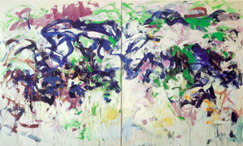Four Memories of Joan Mitchell
Of laps and lapses.
BY John Yau
In 1980 or ’81, Joan Thorne told me that Joan Mitchell wanted to hire a young poet or composer to take care of her dogs. Joan lived in the countryside somewhere outside Paris with Jean-Paul Riopelle. Other than taking care of the dogs, you were supposed to eat dinner with Joan and Jean-Paul every night. Their dinners often lasted hours. It seems they drank a lot and often fought. The longer I listened the worse it sounded.
•
I first met Joan in 1989 at the Robert Miller Gallery when it was in the Fuller Building on 57th and Madison. She was seated at a table with two or three other women when John Cheim brought me into the back room and introduced us. On her lap was a catalog with an essay by me.
She smiled and said, “Look at this. I already have you on my lap. Maybe you would like to switch places.” And that was how we began.
This is the inscription she wrote in her catalog Joan Mitchell (New York: Robert Miller Gallery, 1989) that day:
Dear John
So Glad to have met
you — and you give me
yours on Wed. & here’s mine.
Best Joan
•
I arrived at Joan’s hotel promptly at 11:00am. After speaking with her on the phone, the receptionist told me the room number and pointed to the elevator. Joan invited me in and pointed to the chair I was to sit in, then asked if I wanted some white wine. There was a chilled bottle and two wine glasses on the linen covered table.
At one point — and this was an hour or two later — she said: “Franz (Kline) was a prince.” She was quite dramatic and turned so that I saw her in profile and looked up as she said it. By then a second bottle had been delivered to the room.
She talked about Frank O’Hara and about her studio on St. Mark’s Place. Frank was the only man she allowed in there. Not even her former husband, Barney Rossett, was allowed to go there.
•
I wrote an essay and a poem for her 1992 show, Trees & Other Paintings 1960 to 1990, which was at Laura Carpenter Fine Art in Santa Fe.
A few days after I gave it to John Cheim, he called me and said that I should call Joan, who I think was in France, and ask her what she thought.
I think the reason John was anxious was because I mentioned that Mitchell lived in Véthueil, where Claude Monet had lived and worked. Mitchell disavowed Monet’s influence. In retrospect, she also might have bristled at the mention of Monet because the critic Clement Greenberg believed he was a key figure in the development of modern painting. Joan never lost her enmity for Greenberg, who also said that the painters he was championing had supplanted the Abstract Expressionists, particularly Willem de Kooning and Kline, with whom she was associated. During our only conversation in which his name came up, she waved her hand dismissively, while referring to him as “that toilet seat.”
I was nervous, but I knew that I had to call her and get her to sign off on what I had written. Other than expecting to get an earful of her cantankerous sarcasm, I am not sure what I thought would happen. So you can imagine my surprise when she was absolutely pleasant about the essay I sent her. In fact she was so agreeable that I started to relax, which I should have known was a mistake. But you couldn’t really prepare for what Joan might say, or at least I never could. Just when I thought the conversation was over, she asked: “Do you read T.S. Eliot?” I said, “Sure, I read him.” And then, before hanging up, she said, “I think you have been reading a little too much of him, don’t you?”
Poet, art critic, and curator John Yau has published over 50 books of poetry, fiction, and art criticism. Born in Lynn, Massachusetts in 1950 to Chinese emigrants, Yau attended Bard College and earned an MFA from Brooklyn College in 1978. His first book of poetry, Crossing Canal Street, was published in 1976. Since then, he has won acclaim for his poetry’s attentiveness to visual culture and linguistic...



